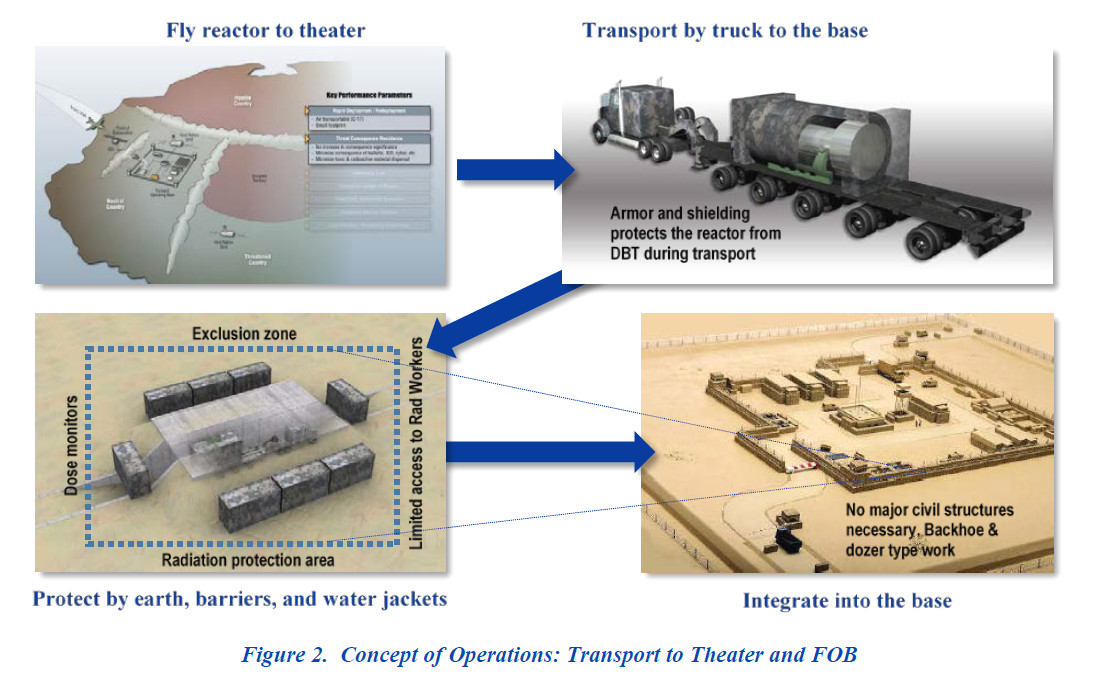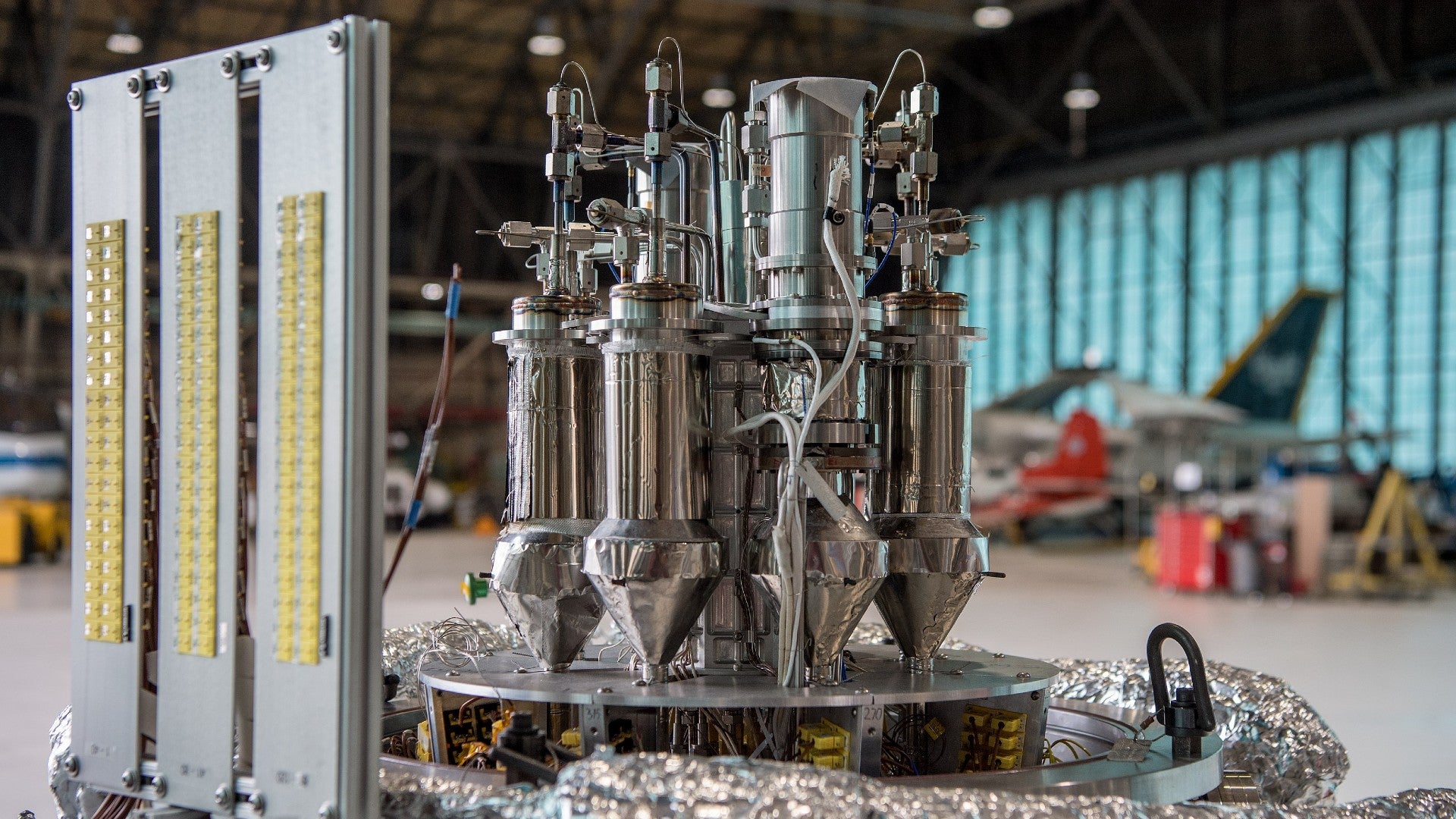President Trump issued an Executive Order on January 12 that aims to promote small, modular nuclear reactors for defense and space exploration applications. According to a press statement issued by the White House, the order will “further revitalize the United States nuclear energy sector, reinvigorate America’s space exploration program, and produce diverse energy options for national defense needs.”
The order instructs NASA’s administrator to prepare a report within 180 days that will define NASA’s requirements and foreseeable issues for developing a nuclear energy system for human and robotic exploratory missions through 2040. The order also calls for a “Common Technology Roadmap” between NASA and the Departments of Energy, Defense, Commerce, and State for implementing new reactor technologies. The full text of the Executive Order can be read at WhiteHouse.gov.

The statement cites American progress in mobile nuclear reactors, the likes of which have generated power aboard submarines and aircraft carriers for nearly seven decades. As competition in space heats up and becomes a more central part of America’s military strategy, the White House is now looking to apply that same level of energy innovation to the stars. “Using small modular reactors for national defense and space exploration will allow the United States to maintain and advance our leadership and dominance across space and terrestrial domains,” the statement claims.
More specifically, the press release states that this Executive Order aims to outline the potential uses the DoD sees for mobile reactors for terrestrial applications, while also pointing to upcoming missions to the Moon and Mars as primary aims for developing new compact reactors for space:
Small modular reactors have the potential to enhance energy flexibility and energy security at domestic military installations in remote locations. At President Trump’s direction, the Department of Defense will establish and implement a plan to demonstrate the energy flexibility and cost-effectiveness of a small modular reactor at a domestic military installation, and will pilot a transportable small modular reactor for a mission other than naval propulsion for the first time in half a century.
Nuclear power sources are essential to deep space exploration, where solar power is not practical. The sustainable exploration of the Moon, Mars, and other locations will be enhanced by small modular reactors deployed from Earth for operations across the solar system. NASA will explore the use of nuclear energy systems for human and robotic exploration missions through 2040. As the United States develops new technology, we will continue to adhere to the highest standards for nuclear nonproliferation and safety.
According to SpaceNews.com, the order also directs the Department of Energy to transition its High-Assay Low-Enriched Uranium (HALEU) project to the commercial sector for further development. That project aims to develop uranium fuels with higher levels of enrichment, allowing for longer-lasting reactor designs with increased fuel efficiencies. Currently, there is no domestic commercial enrichment capability for producing HALEU, and thus the order pushes for new steps towards producing this nuclear fuel.

Creating these mobile, high-powered energy solutions has been a priority for the DoD for some time. In 2016, the DoD’s Defense Science Board (DSB) created the ad hoc Task Force on Energy Systems for Forward/Remote Operating Bases, which issued a report to provide advice to the Secretary of Defense regarding mobile reactors. The task force examined various methods of providing energy to these austere locales, addressing factors such as costs, technical feasibility, safety and security issues, and logistical concerns.
The task force ultimately concluded that the U.S. military “could become the beneficiaries of reliable, abundant, and continuous energy through the deployment of nuclear energy power systems” in the form of very small modular nuclear reactors (vSMRs). While the report cited several obstacles and issues blocking the path to deploying such systems, the report did “not consider any as ‘show-stoppers’ to pursue engineering development and prototyping of vSMR capabilities.”
In 2018, the U.S. Army’s Deputy Chief of Staff for Logistics stated the service wanted its brigades to be able to operate in forward-deployed scenarios for a week without resupply. The incredibly energy-hungry modern military depends on increasingly sophisticated ground-based sensors, artillery and air defense systems, communications networks, electronic warfare systems, and temporary living spaces and mess halls, all of which consume large amounts of power. Directed energy weapons will only make this situation more pressing in the future.
A mobile nuclear reactor that could fit aboard existing cargo aircraft could be a game-changer in terms of how long brigades could operate independently without resupply. Just last year, the Pentagon issued two new contracts for mobile reactors that will eventually transition to the Army.

In 2019, U.S. military’s Strategic Capabilities Office (SCO) requested proposals from potential contractors to develop “innovative technologies and approaches” for “small mobile nuclear power reactors.” The SCO is calling that initiative “Project Dilithium” and hopes to have a reactor that can generate up to ten megawatts of energy while fitting in a semi-trailer or inside a C-17A Globemaster III.
Section 4 of the Executive Order goes into further detail about the DoD’s energy needs, and outlines the role the Department of Defense will play in this new initiative to develop mobile nuclear reactors:
Sec. 4. Defense Capabilities. (a) The Department of Defense is one of the largest consumers of energy in the world, using more than 10 million gallons of fuel per day and 30,000 gigawatt-hours of electricity per year, nearly all of which is provided through civilian electrical grids. Fuel demands for a modern United States military have dramatically grown since World War II and are anticipated to continue to increase in order to support high-energy-usage military systems. In this context, nuclear power could significantly enhance national defense power capabilities.
(b) The Secretary of Defense shall, in consultation with the Secretary of State, the Secretary of Commerce, the Secretary of Energy, and the Administrator of the National Aeronautics and Space Administration (NASA Administrator):
(i) determine whether advanced nuclear reactors can be made to benefit Department of Defense future space power needs;
(ii) pilot a transportable micro-reactor prototype;
(iii) direct an analysis of alternatives for personnel, regulatory, and technical requirements to inform future decisions with respect to nuclear power usage; and
(iv) direct an analysis of United States military uses for space nuclear power and propulsion technologies and an analysis of foreign adversaries’ space power and propulsion programs.
These reactors could also power military bases stateside and provide power to areas impacted by natural disasters.
The Executive Order also outlines a Common Technology Roadmap that “describes potential development programs and that coordinates, to the extent practicable, terrestrial-based advanced nuclear reactor and space-based nuclear power and propulsion efforts” between the Departments of Energy, Defense, Commerce, State, and NASA. This roadmap will also require “assessments of foreign nations’ space nuclear power and propulsion technological capabilities.” Naturally, one of the most pressing concerns with any nuclear technology is national security, and thus the order also instructs the DoD to work together with NASA and other agencies to identify security issues associated with any potential space-based nuclear systems.

With this new Executive Order, the White House seeks to propel the United States to the forefront of all of the work being conducted in compact reactor research. While the wording in the statement focuses more on space exploration, the Department of Defense’s involvement is highly important. Since space environments are similar in that resupply is a tricky, if not impossible, endeavor, NASA could help jump-start the DoD’s mobile nuclear program even further if both are really working on it collaboratively, although the requirements will be somewhat different. “There’s sometimes a risk of forcing too much commonality,” a White House official told SpaceNews.com. “What this executive order does is ensure that there is a deliberate look at what those opportunities may be.”
If realized, the Executive Order’s accompanying statement reads, this initiative could lead to a “transportable small modular reactor for a mission other than naval propulsion for the first time in half a century.”
Contact the author: Brett@TheDrive.com
